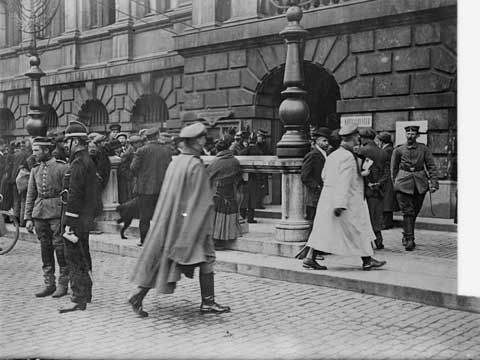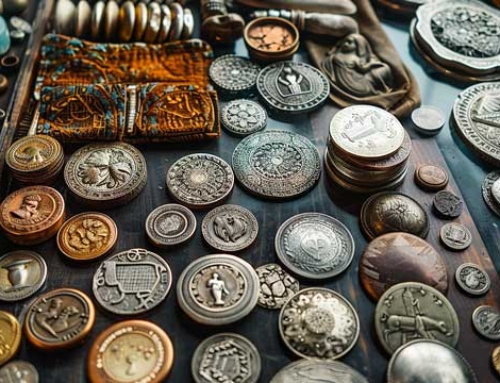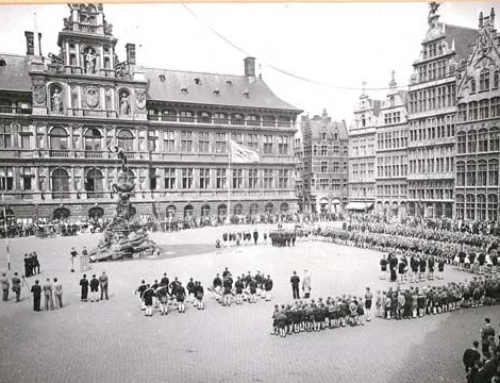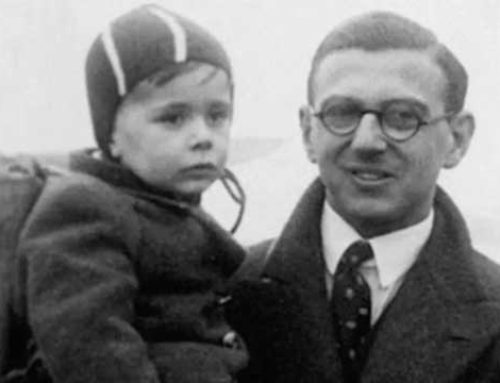Image: German Commandant’s Headquarters in Antwerp during First World War – source: Library of Congress
How did the Belgian diamond sector fare during the First World War and how did it recover afterwards? Strangely enough an interesting subject like this has hardly ever been studied by historians.
During the period of the country’s recovery, however, people attached great importance to it, both the man in the street and the political elite. That the subject was very much alive among the people can be seen in the essay by the famous Antwerp writer Willem Elsschot.
The essay lifts a corner of the veil. We learn that the recovery of the Antwerp diamond sector was associated with the return of some prominent figures, but also that this return was hampered by several factors.
The opinions were divided. On the one hand, the author expresses the opinion of those who, in the name of economic recovery, wanted the foreign diamond merchants back in Belgium; on the other hand, we read that part of public opinion considered them to be “sales boches” who they would rather get rid of than have.
Numerous questions arise. Why do we speak of recovery and return? What exactly was it that hampered the recovery of the sector? Who worked for recovery and in what way? What is the role of the Belgian government in this story? Elsschot’s essay is, as it were, an invitation to further research.
The Antwerp diamond sector before the First World War
The 1910 census lists 1,425 dealers in jewelry and diamonds for Antwerp province. Perhaps there were even more. The membership book of the Diamond Club of 1914 already counted 1,049 members, from the secretariat file of the Diamond Bourse it can be deduced that around the war period it had about 745 members.
The number of Antwerp diamond merchants however is not simply the sum of these two memberships. Many were members of both exchanges, others were not members of any exchange. From the figures of the census we can derive another interesting fact about the diamond merchants, namely that 85% of them did not have Belgian nationality.
The proportion of diamond workers was just the opposite: of the 14 444 diamond workers, 3 011 were of foreign origin, i.e. approximately one in five. The foreign diamond dealers and diamond workers were mainly Jews, rare exceptions to this rule were some Muslim and Christian families from the Ottoman Empire. Thus, the economic core of the diamond sector was almost entirely immigrant and Jewish, yet employed very many natives. The economic importance of the sector could not be overestimated. The fact that the Antwerp diamond sector was actually owned by non-Belgians was at the root of the problems the sector experienced after the war.
First World War
In times of war, an extremely crisis-sensitive sector such as the diamond industry has a very hard time. On top of that, during the First World War a nationality problem arose.
As mentioned the majority of the diamond patrons on the eve of the war were of foreign origin. About half of them were suddenly considered enemies at the outbreak of the war. Nationals of the Dual Monarchy, of Germany and later the Ottomans, were forced to leave the country. Their possessions that they left behind were placed under sequestration.
In addition to the compulsory migration, many chose to leave the country of their own free will. The main part of the Antwerp diamond industry was soon abroad. In addition to the exodus that had taken place within the diamond sector, the sector had to contend with two more problems.
The German occupier imposed a strict travel ban. The diamond sector is an intrinsically international trade, a travel ban means a paralysis of the sector. In addition, diamonds were placed on the contrebande list by the Allied countries in Belgium.
After all, Germany was a diamond-producing power and the Allies wanted to restrict the German economy as much as possible. Consequently, diamond processing was also prohibited in Belgium throughout the war.
The battle for the diamond trade during the First World War
The most prosperous diamond merchants mainly chose to cross the Channel. The Russian patrons who had fled the country after the fall of Antwerp on 10 October also came here mainly.
Diamond traders were welcomed with open arms by the London Syndicate, a cartel that monopolized the distribution of rough diamonds, allowing it to completely set the price. Both traders and workers supported this monopolization, it kept the value of diamonds very stable and was valued by buyers for its fixed value as an investment asset.
The cartel was established by the ten main Jewish diamond trading houses in London after the discovery of rough diamonds in South Africa to prevent these diamonds from flooding the world market.
By 1934, Ernest Oppenheimer, founder of the Anglo American Corporation of South Africa and of the Consolidated Diamond Mines of South-West Africa, had managed to take over the helm of the Syndicate, monopolizing both production and distribution by the extremely powerful De Beers.
Due to the rather closed nature of the diamond industry and the fact that most patrons belonged to the Jewish community, there was already close contact between the London and Antwerp traders. It became increasingly clear that this would be a long and exhausting war.
It became increasingly difficult to rely solely on charity and one’s own reserves. In the course of the war the Belgian manufacturers set up some ten polishing factories in England.
From the British side there was a growing awareness that the presence of the Belgian patrons and workers could give a positive impetus to their own diamond industry. The diamond workers had been less warmly welcomed at first, but over time they were more than welcome.
It was Bernard Oppenheimer (1866-1921), a brother of the renowned Ernest Oppenheimer, who came up with a brilliant idea to make the best use of the available know-how, the capital and the war situation.
He proposed to establish a cutting school in Brighton where the Antwerp diamond workers who had fled would be appointed as teachers. In order to sell the idea to the British authorities, he gave the whole thing a humanitarian touch by training and employing mainly British war invalids in the school.
He also said, “If we don’t do it, the Germans will.” In this way he not only obtained the support of the diamond company De Beers, but also of the entire British government.
In 1917 the site of The Bernard Oppenheimer Diamond Works (National Diamond Factories Ltd) was inaugurated by the British royal couple themselves. It was financed 30% by the Oppenheimer brothers, 20% by De Beers and 50% by the Antwerp diamond merchants Krijn.
The British government covered the cost of training the invalids for six months. The machines and tools were produced in the munitions factory of the same Mr. Krijn. By the end of the war there were 600 war invalids in training, but there was room for another 1,400 men.
However, the lion’s share of the fleeing and deported diamond merchants were not in England, but in the Netherlands. Most of the German and Austro-Hungarian diamond workers settled in the fashionable seaside resort of Scheveningen, near The Hague.
The many Dutch diamond workers who were working in Antwerp moved to Amsterdam after the flight, where most of them could stay with family or friends. In Amsterdam, a strong Jewish minority had already controlled the diamond sector for decades.
In Scheveningen, a new diamond center emerged, as it were. Two exchanges were established. The Belgians established the Cercle Diamantaire. Only Belgians, Allies and neutrals were admitted to this club. The members of this patriotic group, by their own account, remained unemployed throughout the war, refusing to trade with the Germans. A diamond exchange of unemployed, contradiction in terms…
The second exchange was the Antwerpia. Initially founded as a social club, this club grew under Romi Goldmuntz (1882-1960) who played a major role for the Antwerp diamond sector during the First, but especially during the Second World War, to become the most prominent bourse uniting the “Galicians“, the inhabitants of Polish Galicia, a then part of Austria-Hungary. At Scheveningen was one of the 23 refugee camps set up in the Netherlands.
The camp grew into a veritable mini-diamond town with wooden houses, schools, streets, plumbing, electricity and… polishing workshops
As in the rest of the world, the diamond industry fell silent in the Netherlands during the first months of the war. The number of unemployed diamond workers peaked at 85%.
In that context, it is understandable that the many Antwerp diamond workers were considered unwelcome competitors rather than colleagues. The Amsterdam diamond trade union (ANDB) did its best to contain the damage to its own workers by favoring them in several ways.
However, as the war dragged on, it became apparent that this was not purely a matter of protecting its own workers. The Amsterdam-Antwerp relationship had already been clouded before the war because Antwerp seemed to be winning the competitive battle through its very low wage costs, among other things. Antwerp’s paralysis now offered Amsterdam the chance to catch up during the war.
When England decided in 1915 to tighten the trade blockade against Belgian diamonds, the ANDB and the Amsterdamse Juweliers Vereniging (AJV) took it upon themselves to implement this total ban… In order for the trade blockade against Germany to be complete, it was necessary to prevent Germany from importing or exporting via neutral or occupied countries.
The Netherlands was in a quandary when it was discovered that the Austrians were having their diamonds processed in occupied Belgium, but that they were being provided with false certificates of origin by the Chamber of Commerce in The Hague.
The British counter-reaction was to impose a total ban on Belgium and the Netherlands trading in and processing diamonds. However, the ANDB was able to obtain a ban limited to Belgium if they would help to enforce the ban.
The chairman of the ANDB, Henri Polak, and the chairman of the Amsterdam Jewellers Association (AJV), Herman Hartz, together formed the Committee for Export Certificates.
On the English side, the Commission for the Importation and Trade of Rough Diamonds came into being. Together they accomplished much to maintain the diamond trade and processing. For example, England took charge of the transportation of Dutch polished diamonds when the American-Dutch line was no longer usable due to the submarine war.
England also ensured that telegraphic traffic for the diamond industry remained assured. Even then the Dutch government came to the rescue. Insurance for transport by boat had become enormously expensive due to the submarine war. The Dutch government then took it upon itself to insure the cargo of diamonds in a ship up to a maximum of 1 million guilders at a good price.
The trade and processing had a real boom period in the Netherlands during the last two years of the war. The demand for diamonds had risen sharply despite the war period.
In America they gladly converted the easily earned war dollars into diamonds. Unemployment in the diamond sector in the Netherlands, England and America had virtually disappeared. The gap between the Netherlands and Belgium before the war was closed.
It is not surprising that envy and hatred against the Netherlands and England arose in the Belgian diamond circles.
The Antwerp factory owners, traders and workers saw how the diamond trade and processing did resume outside Belgium. In the Netherlands and France more and more workers were able to return to work. Not only the unemployment during the war worried the diamond traders, but also the risk that a too long inactivity would cause the diamond sector to permanently relocate to another diamond center, to the Netherlands, England or even France.
Helplessly waiting for the war to end was not an option. Solutions were sought, both legally and illegally, to help the army of unemployed Antwerp diamond workers find work again and to ensure the survival of the Antwerp industry.
Without German cooperation, diamond trading and processing was not possible. The chairman of the General Diamond Workers Association of Belgium, the socialist Louis Van Berckelaer did not have too many objections to negotiating with the Germans.
He considered war in its entirety a capitalist abomination that was only at the expense of the working class. The Antwerp city council was also aware of the importance of the diamond industry.
So when the ADB leader asked for help here, he quickly found mayor Jan De Vos and aldermen Alfred Cools and Louis Franck willing to help him. They arranged a meeting between the ADB board and Senator Justus Strandes, the head of the Zivilverwaltung (civil administration) for the province of Antwerp. The latter would discuss the matter as soon as possible with Moritz von Bissing, governor general of occupied Belgium, and barely a week later, on 23 February 1915, the ADB leadership obtained the desired special travel passes for diamond traders.
Van Berckelaer believes he owes the German cooperation to their understanding of the importance of diamonds to Antwerp. However, the understanding of the importance of diamonds for Germany will not have been foreign to this either. Given that the German diamond industry was not much, the Germans probably cherished the hope of gaining control of the Antwerp diamond industry after the First World War by keeping Belgium in their sphere of influence….
To be continued…. right here







